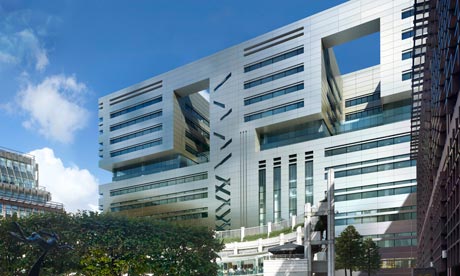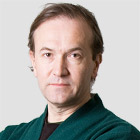5 Broadgate, London – review
The proposed new HQ of Swiss bank UBS is an aloof fortress that ignores its responsibilities to the wider community

Good architects should be able to walk and chew gum at the same time. That is, meet their clients' needs, design well-made and sustainable buildings, and also add something to their building's setting, such as work with their surroundings to create a place more harmonious/ fascinating/ humane/ pleasurable than it was before. 5 Broadgate, a mighty money factory proposed for the City of London, fails to do this, even though its architect is Ken Shuttleworth of Make, who has been lavishly praised by all three of the chairmen, to date, of the Commission for Architecture and the Built Environment (Cabe). "He is one of the best hidden talents in the UK," said one. The second said he was one of the top five architects in the world. The third called his work "extraordinary". Could an architect so brilliant not masticate while ambulating?
5 Broadgate meets every wish of its future occupier, the Swiss bankUBS. It offers 700,000 sq feet of office space, including a stack of dealer floors the size of football pitches. It aims to set high standards of sustainability. It will be, Shuttleworth says, "an expression of the stability of the bank".
To achieve all this requires something big, consuming the sites of two existing buildings. A pedestrian route across the site will be closed, forcing people to squeeze round the edges of the new building's bulk. A covered arcade through the block might have been possible, but this is banned for security reasons, as are shops or cafes at the building's base. The ban is a deal-breaker, apparently: if the City's planners insisted on these humanising touches, UBS would up and go – to Canary Wharf or, worse, Frankfurt.
You might think that UBS is being unduly touchy – it could surely hire enough security to keep al-Qaida or student rioters out of an arcade or coffee shop – but it is not surprising that the planners would want to avert a Swiss flounce. Given that the shaky edifice of the British economy is in thrall to financial services, they would not want to bring down such a heavy blow for the sake of a bit of permeability for pedestrians. There is not much Shuttleworth can do with these macroeconomic forces, and it could be argued that the accommodation of brute finance is what the special enclave of the City of London is about. He can't pretend his building is not big. But he could try to reconcile the scale of the new building with its surroundings.
The site is in Broadgate, the 1980s development highly praised for the unity of its design, for the ways it makes a whole greater than the sum of its parts and its open spaces more important than individual buildings. There have been calls for Broadgate to be listed, which would be overly precious, but one might hope that a new building respects its principles. It shouldn't try to mimic its neighbours, but its rhythms, proportions and materials could create resonances or rapport between the new and the old.
Instead, Make's design announces with maximum force that it is an aloof fortress. Bankers, it says, are people apart from the rest of us. Its windows are defensive horizontal strips in a cliff-like wall. There are terraces high up for the use of UBS staff, but this glimmer of life is suppressed by the hard geometry. It is armour-plated in aluminium (an energy-ravenous material, by the way, although Shuttleworth says he will work with manufacturers to make this the greenest possible aluminium). There is no softening: not a curve or a piece of greenery. The existing buildings, which have layers of stone screens in contrast to the new one's sheer metal, are ignored. We are invited to admire it as a vast piece of sculpture, where the bank's wish for an expression of power perfectly aligns with the architect's desire for a singular artistic statement.
One of the best things that ever happened to Shuttleworth was when Make, now seven years old, was newly founded. His former employer,Norman Foster, had him erased from a group photograph like a victim of Stalin's purges, which supported the image of him as the suppressed creative genius behind Foster projects such as the Gherkin. With the help of some fervent press, a legend was created of "Ken the Pen", a dazzling whiz of a draftsman. He also combined his radical reputation with securing positions of influence. He became a Cabe commissioner and a member of its Design Review Committee, which judges the quality of significant projects. He became Cabe's "champion for schools and the East Midlands".
Commissions flooded in, for significant commercial developments, for private homes for property developers, for the Olympic handball arena, for schools. Make's reputation rode high, even when its completed buildings consisted mostly of a judo hall in Dartford, and the Jubilee Campus at Nottingham University, a set of wedges mottled with a psoriasis of red cladding. The campus was nominated for Building Design magazine's Carbuncle Cup, for the worst building of the year, albeit also for the prime minister's Better Public Building award, sponsored by Cabe.
Make presents itself as everything Foster and Partners are not: collegiate, open to ideas from even its most junior staff, and with no house style. Publications about the practice include pictures of staff weddings and holiday snaps. Profits and credit are shared. It calls itself a "studio", stressing its creative side. Shuttleworth says he wants to create "the best buildings in the world" and above all be sustainable. "I want to save the planet," he says.
Make stress how important clients are, how each one is special, and how its buildings respond to each unique set of needs. Clients of Make praise the company as responsive and professional, and these virtues are obviously important ones. What is lacking is a core of principles: a Make building tends to be as good as its brief, with Ken the Pen's flourishes giving a dressing of art. If UBS wants a defensive-aggressive citadel, it gets it. On another site in the City of London, called London Wall Place, where the planners are being more demanding, it has produced a more subtle design. In Birmingham they have built the Cube, a block of shops, offices and flats, which brings a bit of flash and sparkle to a site that probably needed it.
Make is a perfect distillation of 00s architecture, where genuine professionalism, slick stylishness, and a real if well-advertised commitment to the environment are boosted by hype and infinite adaptability to the demands of the market. This combination makes it an above-average commercial practice. It does not make its employees the hidden geniuses, or the world-top-five architects that their mates at Cabe or some excitable journalists claimed them to be. It says much for the poverty of architectural discourse that anyone could have imagined that they were.

No comments:
Post a Comment